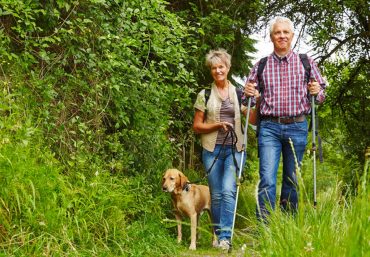 Adapting to the pandemic for the past year has made exercise and physical fitness difficult, but there are still ways to remain active. And with spring in the air, it’s the perfect time to get back outside and moving.
Adapting to the pandemic for the past year has made exercise and physical fitness difficult, but there are still ways to remain active. And with spring in the air, it’s the perfect time to get back outside and moving.
For aging adults, physical fitness is even more important to keep joints flexible and muscles strong — and now, to prepare the body to get back into an active lifestyle.
It’s not just professional sports players who’ve been sidelined during the COVID-19 pandemic. A study by the University of California San Francisco monitoring the daily step count for smartphone users showed a nearly 50 percent drop in physical activity after the World Health Organization declared a pandemic last March. Prior to the pandemic, barely half of Americans were meeting the recommended levels of aerobic exercise, and fewer than a quarter met the recommendations for strength training.
Here are some flexible tips and tricks to get motivated to get moving again:
More Moving. Less Sitting.
Like the old saying goes, a rolling stone gathers no moss. It’s important to remain active and avoid long periods of stasis.
Try to make it a point to walk around or do a chore during a TV show commercial break or during any downtime. With spring in full bloom, it’s the perfect time to go on a walk, enjoy the fresh air and soak up the sun.
Practice Different Types of Exercise
Like a balanced diet, it’s important to vary your exercises to get all the benefits possible. There are four types of exercise: strength, endurance, flexibility and balance. The National Institute on Aging provides a list of different activities for each category.
Strength is great, but it means nothing if adults don’t have the flexibility to move the way they want to. By doing all forms of activity, your body will remain mobile for years to come.
Make Time for Your Health
Exercising doesn’t have to come all at once, and it doesn’t have to control your daily schedule. Taking time to devote part of your day to health will make a difference in the long run.
Early birds can take time when they wake up to go on a brisk morning walk. And night owls can go on an evening walk with loved ones after dinner. Get more out of exercising — don’t make it a chore.
Listen to Your Body
Staying active can keep aging bodies strong, but they’re also more fragile so it’s even more important to listen to your body. Warming up before exercising and cooling down after exercising will help your body avoid the shock of sudden exercise.
The “talk test” can help determine whether your body is being pushed too far. You should be able to talk, but not sing, when vigorously exercising.
The Myth of Exercising when Older
Many older Americans may think, “What’s the use of exercising? I’m already old.” But it’s never too old to become active, and regular exercise can help you feel younger and stay independent longer.
Exercise does not open you up to injury, either. In fact, by regularly exercising, you can prevent muscle and bone density loss, reducing your risk of injury.
Get Enough Sleep
Getting a good night’s sleep is necessary for having the energy to be active. The body needs seven to eight hours of sleep a night to “reboot and recharge.”
Fuel Your Body
Processed and sugary foods are tasty and easily available, but they don’t contain the nutrition that aids in physical activity. The next time you’re hankering for candy, try eating whole grain bread instead.
There has been a large uptick in alcohol consumption over the past year as people have been forced to stay home because of COVID-19. But beer and wine do not have the macronutrients to fuel an active lifestyle.
Staying active is one of the key components in a healthy lifestyle, not just to look good and feel good. Staying active makes your immune system stronger in fighting against disease. The last year has made one thing clear: Health is not something to take lightly.























